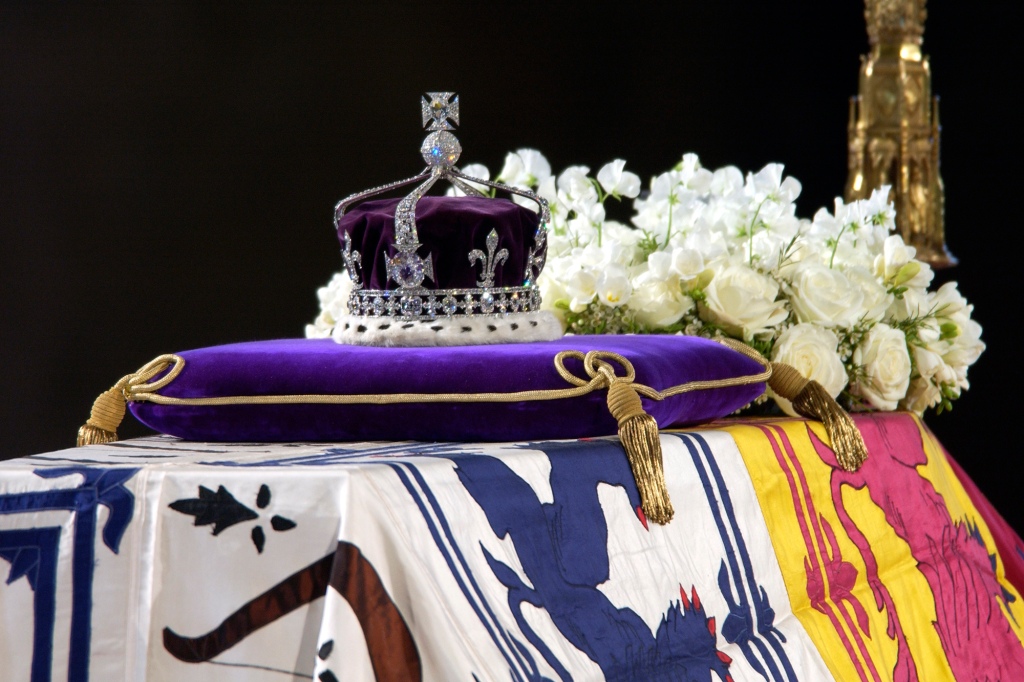The bloody history of the Kohinoor diamond – the royal jewel everyone’s talking about
Following Queen Elizabeth II’s death last week, critics have renewed calls for the British government to return artifacts looted by the British Empire, among them the Kohinoor diamond – one of the world’s most famous, controversial gems.
Housed today in the Tower of London as part of the Crown Jewels collection, the diamond is subject to claims of ownership from multiple countries. It is rumored that it will be worn by Camilla, now Queen Consort, at the coronation of King Charles III.
Originally about 186 carats uncut, the Kohinoor, or “Mountain of Light,” was likely mined in South India in the 13th century. Some Hindus believe it to be the Syamantaka gem from the Bhagavad Purana tales of the god Krishna.
According to Smithsonian Magazine, the stone first appears in the written record in 1628, when it formed the glistening head of the so-called “Peacock Throne” of the Mughal Shah Jahan. Despite its impressive size, the Kohinoor played second fiddle to the Timur Ruby, as Mughal culture preferred colored stones.
After a century in Mughal hands, the diamond was subsequently captured by the Persian and then Afghan empires. It was finally returned to India in 1813 by the Sikh Maharaja Ranjit Singh. In the book “Koh-i-Noor: The History of the World’s Most Infamous Diamond,” historians Anita Anand and William Dalrymple note Ranjit Singh’s acquisition as a major turning point in the gem’s history.
“It was not just that Ranjit Singh liked diamonds and respected the stone’s vast monetary value; the gem seems to have held a far greater symbolism for him,” they write. For him, it represented the conquest of the Sikh Empire against the Afghan Durrani dynasty.
The diamond’s almost mythical potency appealed to Britain’s East India Company, which began its plunder of the Asian subcontinent in the early 19th century. Even so, the diamond remained in India until 1849, when Ranjit Singh’s son Maharaja Duleep Singh signed the Treaty of Lahore. Only a child at the time, Duleep was forced to acknowledge the British annexation of Punjab – and turn over the diamond.
Lord Dalhousie, the Scottish governor-general of India, oversaw the stone’s export to England, where it was unveiled at the 1851 Great Exhibition. Viewers were originally scandalized by the Kohinoor’s dull appearance; to avoid more public outcry, Queen Victoria’s husband Prince Albert had it recut and polished.

Around this time, rumors also started spreading that the famous gem was cursed. Whispers circulating that any man who wore the diamond would experience great misfortune, or that it spiritually saturated with the bloodshed of historical conquests.
Perhaps in part because of the rumors, the Kohinoor never became a star of the royal collection. Worn occasionally as a brooch by Queen Victoria, it was eventually set in the crown of Queen Alexandra and then in that of Queen Mary. In 1937, it was refashioned as the central diamond on the crown of Queen Elizabeth, The Queen Mother.
The Kohinoor crown last appeared in public in 2002, when it was placed on top of The Queen Mother’s casket at her lying-in and funeral.
Meanwhile, the Indian government has been demanding the diamond’s return almost the entire time the stone has been in British hands. The country entered a formal complaint upon gaining independence in 1947; it was followed up upon Elizabeth II’s coronation in 1953. The governments of Pakistan, Iran, and Afghanistan have lodged similar claims.

The British government has historically rejected the idea of returning the Kohinoor. In 2013, then-Prime Minister David Cameron said “They’re not getting it back.” Three years later, the Indian Culture Ministry insisted that it would make “all possible efforts” to see the diamond back in India.
Now, as the death of Queen Elizabeth brings renewed criticism of the dark history of the British imperial project in Asia and beyond, social media users are rallying to put the Kohinoor issue in the spotlight.
“If the King is not going to wear Kohinoor, give it back,” wrote one Twitter user.
Another user tweeted “Can we get our #Kohinoor Diamond back[?]”
“They created wealth on others [sic] Death, famine, Torchers [sic] & Looting.”
Speaking to NBC, Danielle Kinsey, a professor of history at Carleton University, says it is only a matter of time before the diamond is returned.
“At some point the monarchy will understand that keeping the diamond is more of a public relations liability for them than an asset,” she said.
“I think the same is true for many, many looted artifacts in Britain today and the institutions that house them.”
Indeed, the Kohinoor is far from the only foreign treasure lingering on British soil. Not only does the Crown Jewels include several other controversial gems – including the Timur Ruby, the same stone that formed part of the Peacock Throne with the Kohinoor in the 17th century– but the country’s museums are overflowing with looted goods.
While the British Museum remains locked in a famous feud with Greece over the Elgin marbles, other institutions are becoming more willing to return what was never theirs. In August, the Horniman Museum and Gardens vowed to return 72 Benin bronzes to the Nigerian government.
Despite the small progress being made, British-Indian author Sauruv Dutt, told TIME that he doubts the Kohinoor or its peers will be back in their origin countries anytime soon.
Describing how the monarchy is “married to this romantic version of empire, even though it is long dead, and has lost its power,” Dutt said the diamond would be impossible for them to surrender.
“[The Royals] would essentially be eviscerating themselves.”
Read the full article Here


